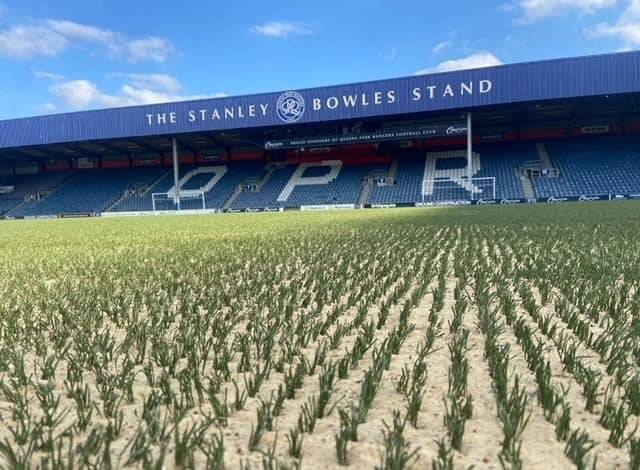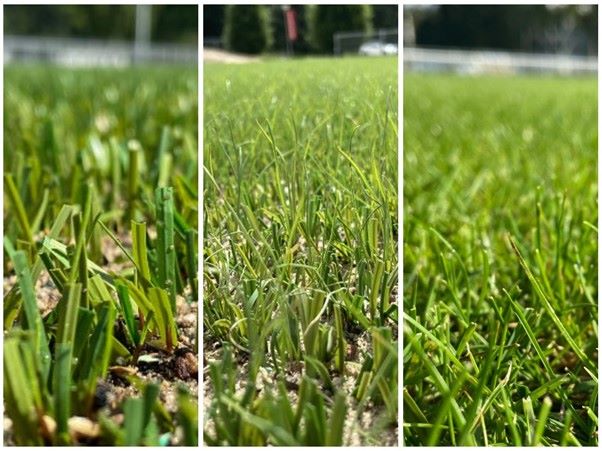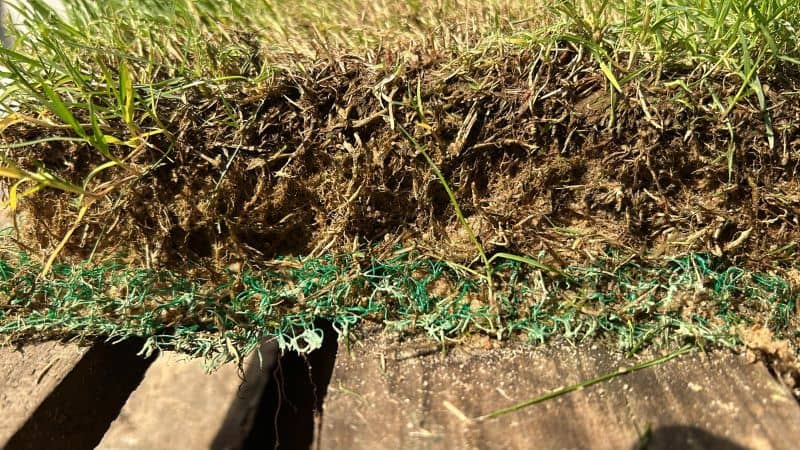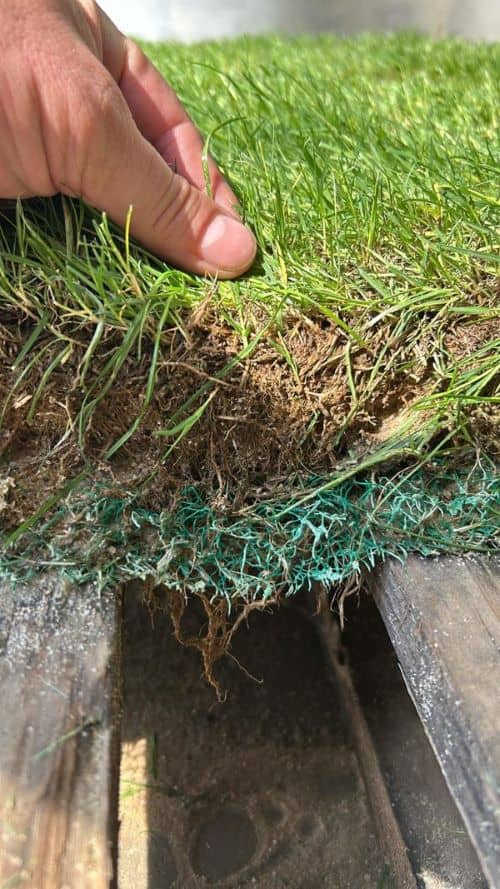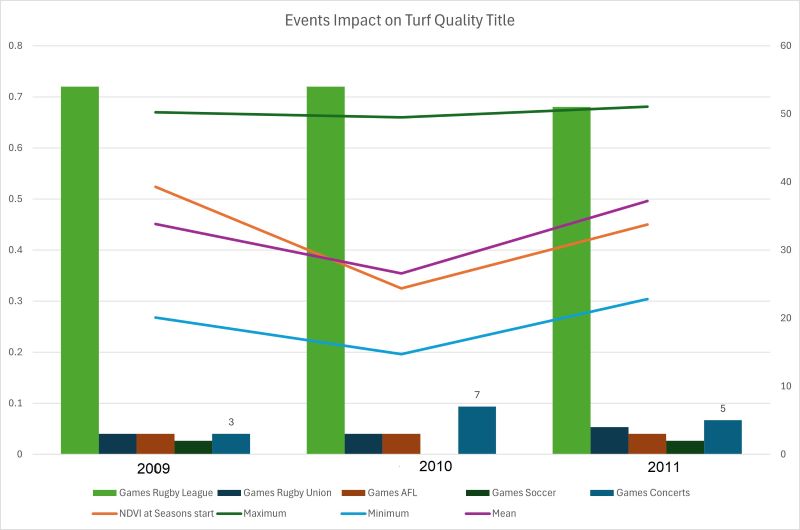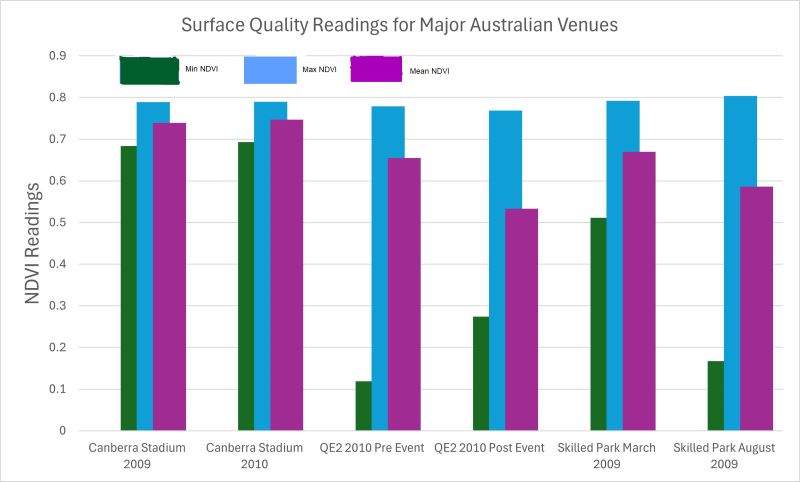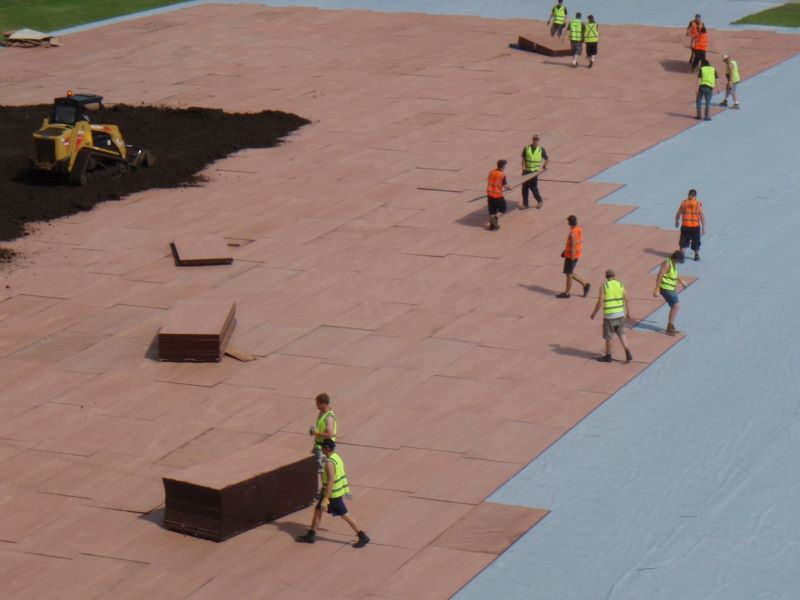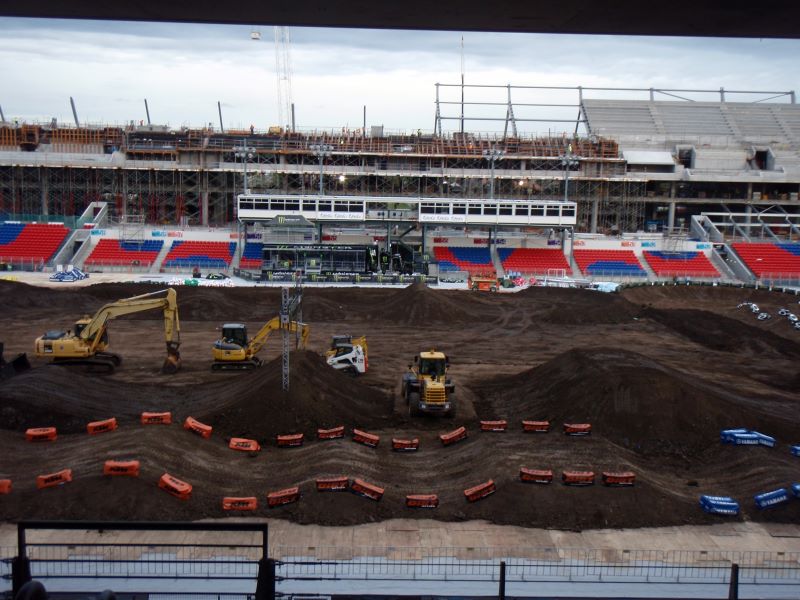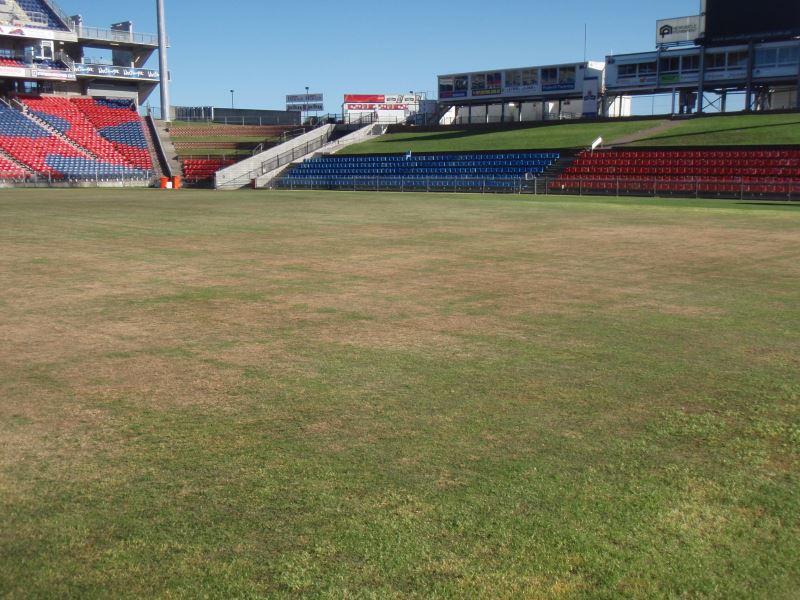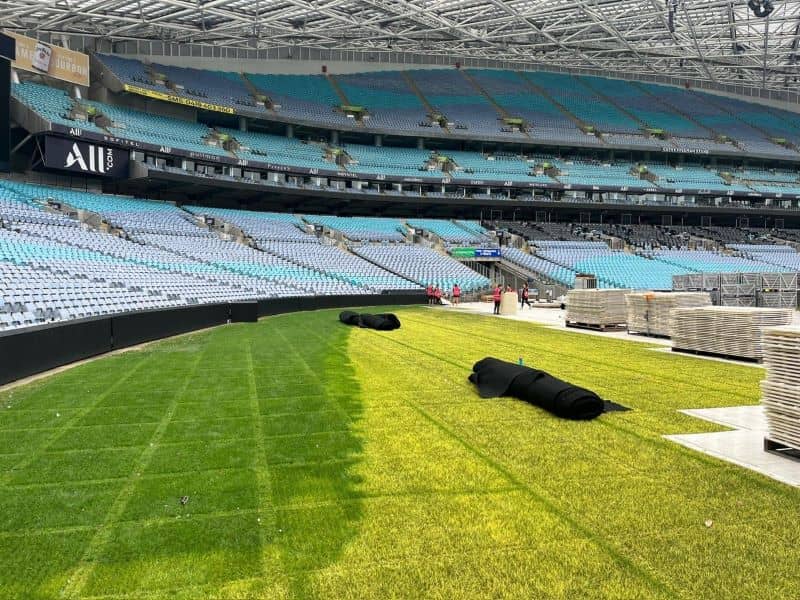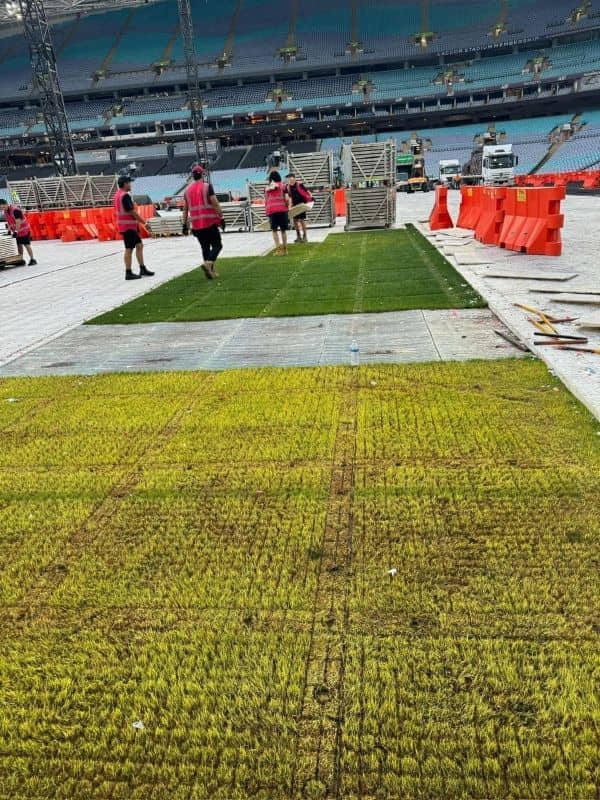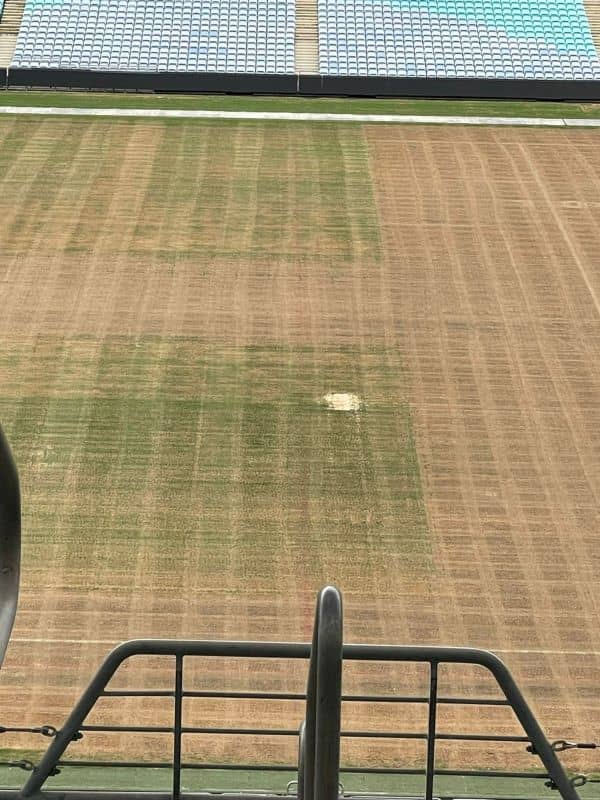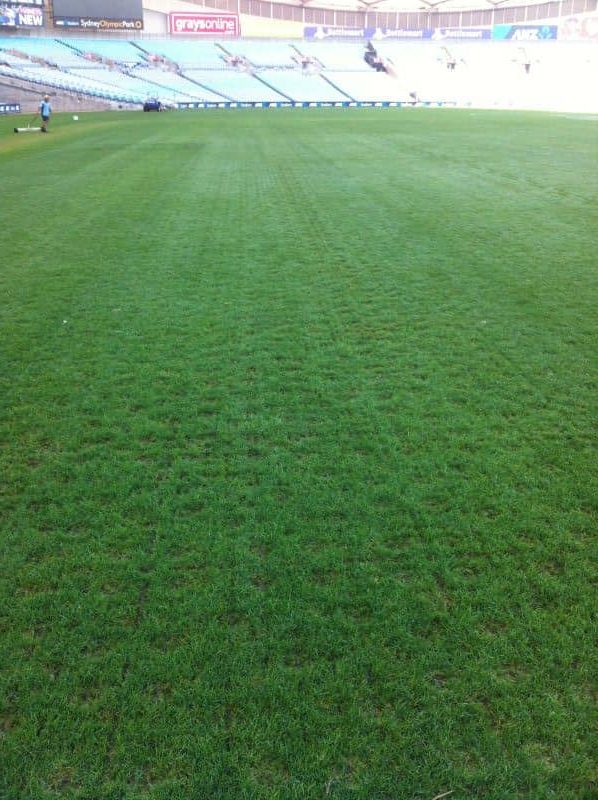How to Manage Turfgrass for off-season events.
Managing turfgrass for off-season non sport events raises several unique challenges for stadium turf management. In recent years it has become even more demanding due to several factors. This article covers the following:
- What are now the out-of-season stadium turf management challenges?
- How can we manage this better to provide safer, more sustainable turf surfaces that satisfy all stakeholders from Stadium tenants to Stadium hirers and promoters? and
- How do we improve stadium turf management, to maintain turfgrass quality for off-season sports events.
Out of Season Concerts, Moto Cross, boxing, UFC and even large-scale theatre productions are now more the norm than the exception. All of these have a major impact on turf quality for all the Winter sporting codes in Australia.
History of Managing Turfgrass for off-season events.
Historically, non-sport events in a Stadium would happen in a gap in a venues sporting calendar. However, with the cross over of playing seasons for A-League, Super Rugby, NRL, AFL and Cricket, it is now common for stadia to operate all year round.
Generally, concerts and events happen from October to March. This is when the weather is more predictable, and ensures that the event is on when there is less risk of inclement weather. This window for events is more attractive to event promoters, and almost guarantees a better ROI for all parties.
Stadiums in Australia are assets that in principle are owned by the respective state governments. The stadium turf management is managed and operated by either an internal or external operator under contract.
They are a business, and large-scale off season events generate significant revenue streams. This helps to balance the books, when for some sports codes attendance numbers are in decline.
The hosting of events does however have an impact on the turfgrass quality. There is therefore a knock on effect for both the agronomic and playability performance of the surface.
New Challenges For Turf Managers.
This article looks into the modern day challenges of Stadium Turf Management. It examines the available options to turn venues around from non-sport event mode back to sports surface mode with the aim being to satisfy all the stakeholders.
Historically, once the Winter sports season finishes, Stadiums are put to sleep until the next season. Now Turf Managers have to plan up to 12 months in advance.
This increase in out of season events, occurs at the same time there is a massive increase in women’s sport. The result is that Turf Managers are now under more pressure to produce a high turf quality surface. This is despite there being vastly more wear and tear on the surface, and raises a new range of out-of-season stadium turf management challenges.
We are also seeing an increase in combined event days. This is when stadia host double headers or multiple codes in quick succession.
It is not uncommon for Allianz Stadium, AAMI Park Stadium, and Suncorp Stadium to have 3 different sports codes over one weekend that require changeovers of posts, line markings, mowing patterns, length of grass etc.
Events such as Super Round in the SRP, Gather Round in AFL and Magic Round in NRL, have become the norm and challenge the patience and abilities of the finest turf managers.
The Impact of TV.
TV is an unforgiving mistress and as events are televised nationally, they have come under an unprecedented level of scrutiny from so called ‘’arm chair’’ experts. Often they have no idea what happens in the off season, the history of the venue, or the stadium turf management challenges to get surfaces in top condition for professional sport.
- What are the impacts of these out of season events on the turfgrass surface quality?
- Is it possible that we are heading to a point where the demands on the surfaces has reached a tip off point?
- How do we manage these out-of-season stadium turf management challenges.
The Quick Fix.
The quickest and often best fix is to simply replace the surface with a “lay and play” product. The use of “Lay and Play” or “Ready to Play” systems from companies like HG Turf Group and Evergreen Turf, means that a full field replacement can occur in 3 to 5 days, and play commence almost immediately post installation.
The ideal scenario is that after an event the Stadium replaces any damaged turf, and the Venue then passes on the replacement cost to the hirer.
However, there are a number of considerations and challenges when you adopt this approach:
- It takes around 12 months to have an entire surface ready. So unless you have a crystal ball how do you know exactly how much turf to grow?
- If there are multiple events one after the other, how do you know who causes the damage to the playing surface? Who gets charged?
- Who pays to maintain and grow this surface on the off chance it is used in the future?
- In Sydney’s case, many of the turf farms are in a flood zone. This raises the possibility of silt or fines contamination of these replacement systems which means an increase in potential for rootzone contamination.
At best you are making a calculated guess 12 months out from an event. The alternative is you just replace the entire surface at a significant cost of over AUS $1 million a time.
The Difference between a “Lay and Play” and Hybrid Turf System?
Lay and Play Turf Systems have now been around in Australia for over 15 years. It is important to note that new hybrid technology has now superseded older stabilised or profile enhanced lay and play turf systems.
A “Lay and Play System” or stabilised turf is not a Hybrid Turf System. For example, the 2023 Women’s World Cup in Australia FIFA stipulated that the playing surface has to be a hybrid surface.
Hybrid grass technology generally comes in two forms:
- A carpet type system that is laid out to produce a ready to play turf hybrid or
- A stitched hybrid system. This literally uses a large sowing machine to stitch synthetic strands of fibre into the playing surface.
Often professional sport use these systems due to their ability to meet strict performance criteria imposed by governing bodies. These include tests on hardness, rotational resistance, shear testing, energy restitution, ball bounce, ball roll plus a whole range of agronomic requirements on drainage rates, infiltration, and organic matter.
A hybrid surface comprises a sand infilled polyethylene fibre carpet, with grass grown in this infill. This looks and performs like a standard grass surface, but has more support and stability due to the polywoven fibres.
These turf systems have a proven global use history. For example, the majority if not all the Premier League grounds in the UK are hybrid systems, as well as these same clubs have many more at their training facilities.
Hybrid Pitches in Australia.
In Australia, there are several high profile examples. These include AAMI Park in Melbourne, Optus Stadium in Perth, MCG in Melbourne, Adelaide Oval in South Australia and Suncorp Stadium in Queensland. These all look like it is 100% natural turf, but the surface is in fact 3 to 5% synthetic fibres.
In contrast to the hybrid turf system, a “Lay and Play System” does not necessarily have these supporting synthetic fibres. This means they can be a turf system grown on a plastic slope stabiliser or a plastic mesh. Yes you can use these for rapid turf replacement, but they do not offer the support and surface stability of a true hybrid. From a players safety perspective this is an important difference.
Research.
Field research carried out in 2018 at Michigan State University (MSU), Iowa State University (ISU) and the University of Tennessee (UT) shows that the Hero hybrid system, in use in Australia at venues such as the MCG and AAMI Park, gives a safe and stable surface even when there is minimal grass cover.
Use Limits.
However, even with hybrid products once you damage them, you need to repair them. Much like standard grass fields, they have limits on the amount of use they can take.
The problem is that even though you can replace an area within 24 hours, it is often not a readily available resource unless venues pre-order and contract grow in advance.
Instead, you have to resort to use of a variety of turf system solutions, turf types or in some cases washed turf. The end results is that surface unformity is lost.
The increase in Womens’ participation in sport
The increase in demand for a range of content, increased participation in Women’s Sport and the need for venues and State Governments to attract global artists that generate revenue and boosts the economy is here to stay. Hand in hand with this are new challenges in stadium turf management for these sports surfaces.
Some venues now receive up to twice the amount of use they did 10 years ago. This is not a criticism, but it is an issue that needs to be raised. If you have more use on the same sized area it’s going to get more wear.
So this raises the question of what are the limits to use, and what are the long term impacts of events on top of this increase in participation?
Long-term usage study into The Impact of Events on Turfgrass.
In 2009-2011 work was carried out on several Venues in the ACT, NSW and QLD to study this. The major Sydney Venue, was ANZ Stadium (now Accor Stadium), which was one of the more heavily used venues in the southern hemisphere.
Other Venues included Newcastle Stadium, Canberra Stadium, Skilled Stadium and QSAC in Brisbane.
Study outline: Managing turfgrass for off-season events.
There are several tools to test turfgrass quality, but in this case it was limited to an NDVI. The NDVI gives you a completely unbiased snap shot of the surface quality at any point in time on a scale of 0 to 0.9. The higher the reading the better the turf quality.
It is predominantly used to measure turfgrass colour. However, if you accept that a heavily worn surface has less grass, and so gives a low reading and full cover gives a high reading, you can use it to get some idea of surface condition. Yes it is simplistic, but it’s a quick and easy method.
Condition Before the Season Starts.
The surface condition of the turf at the start a season, has a huge impact on how you manage turfgrass for off-season events for the next 12 months.
As use increases, this becomes even more critical. From our results there is no statistical difference between the maximum and mean readings over this period. In contrast there is a significant difference in the minimum readings.
If an area is thin, badly worn or damaged it remains like this unless given a lengthy period to recover i.e. no further use, or you use a replacement turf system.
Table of Minimum Reading Variation over a season for Accor Stadium.
| Year | NDVI at Season Start | Maximum NDVI | Minimum NDVI | Mean NDVI | No. Rugby League Games | No. Rugby Union Games | AFL Games | Soccer Games | Concerts |
| 2009 | 0.524 | 0.67 | 0.268 | 0.451 | 54 | 3 | 3 | 2 | 3 |
| 2010 | 0.325 | 0.66 | 0.196 | 0.354 | 54 | 3 | 3 | – | 7 (3 before start of season) |
| 2011 | 0.45 | 0.681 | 0.304 | 0.496 | 51 | 4 | 3 | 2 | 5 |
Timing in Managing Turfgrass for Off-Season Events.
When you plot the results against the number of events, you can see that year to year the actual number of events does not vary that much. It is the timing that has more of an impact on the condition of the surface for the upcoming season.
For example, in 2010 the value of 0.325 going into the start of the NRL Season was significantly lower than the readings in other years. The reason? Prior to the season start the surface was subjected to 3 concerts, and these impact on the surface condition for the rest of 2010.
Managing turfgrass for off-season events – Turf Condition at The Start of the Season.
From the above results you can see that the better the surface before the season starts, the better it remains through the season.
- The maximum readings remain consistent over the entire duration of the season.
- In contrast the minimum readings are significantly lower.
What this means is that once damage occurs to the turf, it seldom gets time to recover through a playing season. This is because ongoing use continues to impact on these areas. We can use this fact as a basis to better schedule turf replacement on heavily worn areas.
This state of affairs is not an issue for Accor Stadium alone. This same conclusion occurred at other grounds such as Newcastle’s Energy Australia Stadium, QSAC in Brisbane and Skilled Stadium on the Gold Coast.
Excessive use has a major negative impact on the surface, and this raises a range of out-of-season turf management challenges.
The issue has always been how to determine at what point do the ‘’wheels actually come off’’, and the surface becomes unacceptable from both an aesthetic and safety perspective?
Other Points of Note.
-
- At the time of this work, Canberra Stadium had the most consistent turf quality.
- Excessive training under adverse conditions, leads to a deterioration in surface quality (Skilled Park).
- The best areas remain ‘the best’ and the worst areas become worse (Skilled Park). Excessive use of the same worn areas, leads to further deterioration. The main field did not have this usage and remains at a consistently high level.
- The QE2 data was pre and post a Motocross event. The overall condition of the site deteriorated where it was covered.
Managing Turf grass for off-season events.
There are however, several options to manage turf grass that reduce the costly need to replace turf and cut costs.
Unfortunately, the sad reality is that these are often not taken, as managers regard these as an unnecessary additional cost. From our experience the failure to take preventative action is just a gamble, and often leads to significant additional costs to rectify any damage that does occur.
Is this approach really worth it when it results in poor publicity and a loss in revenue as a result of the ground being out of use?
Turf grow Lights.
You regularly find these in top tier Venues to manage turf grass in shade. The majority are High Pressure Sodium (HPS) rigs but there is thankfully now a rapid move toward LED units that use significantly less power, and have a much smaller environmental footprint.
Companies like SeeGrow have taken the entire Turf Grow Light concept one step further with their LED units. These are not only a tool to better manage shade, but they are an effective means to increase turf recovery after off season events.
These mobile units have a CO2 canopy, and achieve growth of up to 10 mm shoot and root growth in 24 hours. Examples of these are currently being used at Comm Bank Stadium in Parramatta.
Protective Flooring.
Choice of Protection.
Concert Flooring.
- High traffic areas such as the main entry and exit points, and any roadway in use for vehicle access.
- As an all purpose pitch cover to protect the surface from general wear and tear, and pedestrian traffic.
Materials and Technology.
Flooring systems use a variety of materials, but all should have the following characteristics to ensure better stadium turf management:
- They should be able to cope with heavy loads such as vehicles, cranes, and staging equipment, whilst also protecting the turf from compaction and damage. Flooring systems like Stadia XHD, TerraTrak and Supa-Trac are particularly beneficial in high-traffic scenarios like concert setups in stadiums.
- Allow light and air to pass. If they allow sunlight to penetrate to the turf canopy, it allows photosynthesis to continue. This reduces turf stress under long-term coverage. Products like Terraplas translucent tiles and Covermaster’s MasterShield emphasise turf health even under heavy use. These also allow air movement to reduce the chance of disease.
- Be modular. There is often only a small amount of time between events, and so any flooring system must allow for quick installation and removal without the use of specialised equipment. For example Stadia XHD is a plug and play modular system that offers installation rates of 55 m2 per man hour, and doesn’t involve the use of any tools.
- A flooring system must ideally be suitable for a range of situations, These range from pedestrian light foot traffic to heavy-duty flooring for vehicles and equipment. Products like Stadia XHD cater to diverse needs, and offer appropriate solutions for specific event.
- Not be metal. All of the examples below are plastic.
Examples of Protective Flooring Available in Australia.
Matrax HD | Matrax LD | Stadia XHD | Stadia X | Itrac | Supa-Trac | Mastershield Trax | Terraplas HD | Terratrak Plus | Terraplas | Terratrak | |
Company | Signature Systems | Signature Systems | Box Group | Box Group | Groundtrax | Groundtrax | Covermaster | Terraplas | Terraplas | Justrite Safety Group/ Terraplas | Terraplas |
Panel Size | 1.2m x 1.2m x 3.8cm | 1.2m x 1.2m x 3.8cm | 2.8m x 0.5m x 5cm | 0.2875m x 0.2875m x 3cm | 1.2m x 0.92m x 5.4cm | 0.92 x 0.23 x 3.4cm | 1.25m x 1.25m x 3.81cm | 1.22m x 2.13m x 5cm | 2.42m2 | 4m2 | 4.84m2 |
Weight | 22.7Kg | 13.8Kg | 30Kg | 1.33Kg | 15.6Kg | 2.025Kg | 21.5Kg | 42Kg | 46Kg | 50kg | 52kg |
Static Load | 3100kpa | 1551kpa | 150 tonnes/m2 | 80 tonnes/m2 | 200 tonnes/ m2 | 80 tonnes/m2 | 3100 Kpa | 2757 Kpa | 2551 Kpa | ||
Traffic Load | 2068kpa | 12.5 tonnes | 2.5 tonnes | 15 tonnes per axle | 3.5 tonnes/m2 | 2068Kpa | 4688Kpa | 7218Kpa |
| ||
Translucent | Yes | Yes | Multiple colours and translucent | Not translucent | No | Perforated | Yes | Yes | Translucent | Yes | Yes |
Warranty | 10 years | 5 Years | 30 years | 20 years | 30 years | 20 years |
Program for Managing turfgrass for off-season events.
As turf agronomists we work with many venues to develop good agronomic and stadium turf management programs to prevent turf damage from temporary stages and equipment. This ensures that by managing turfgrass for off-season events, that the turf has the best chance to be in the best condition afterwards by preserving your existing turf.
Stadium Turf Management Tips to Limit Damage from Stages and Equipment.
We advise against doing the following before an event is held or covers are put down.
- Don’t apply a high N fertiliser and juice up your turf. This makes it more prone to damage and disease.
- Don’t irrigate the turf. This increases the chances of damage as it makes the surface soft.
- Aim to mow your turf as short as you can without damaging it. High cut turf is more prone to damage.
- Use PGR’s. The aim is to time the application so that its affects wear off when the floor is lifted.
Managing Turfgrass for Off-Season Events: Motor-Cross Case Study.
Below is a case study from a Moto-Cross event held in NSW. The brief from the Venue Manager:
- Maintain the free draining nature of the drainage medium.
- Do not contaminate the subsoil.
- Minimise any surface damage due to plywood boards being pushed into the surface, and through the underlying cloth.
- Avoid any disease outbreaks.
The original program was as follows:
- Prior to the event lay 190 GSM (grams per square metre) bidim cloth over the entire area. Make sure that there are no tears or holes present in the cloth.
- Cover the area with clean, dry, plywood boards and place the imported soil over the top of these. Do not use boards that are warped or wet.
The bidim cloth is in use to prevent contamination. The plywood boards help “spread the load” of heavy machinery that is used to shape the soil, and also of the soil itself.
Maintain the Freely Draining Nature of the Rootzone.
“Maintain the freely draining nature of the existing drainage medium at XXXX Stadium, and prevent subsoil contamination.”
A 190 GSM bidim cloth was proposed to act as a geotextile membrane. This let too many fines through to the turf surface, and was prone to tearing.
Recommendation for Managing Turfgrass for off-season events.
A heavier cloth of GSM 300 or higher. This is more tear resistant, filters out more fines, and actually helps to reduce the damage to the surface from traffic.
A suitable option is A34 geotextile which is much stronger and doesn’t tear as easily.
Plywood boards and possible alternatives.
The plyboards are 2.4 m x 1.2 m x 15 mm thick. If these are left on the surface for a length of time severe damage occurs. This is due to the pressure of the soil, and the weight of the vehicles used to transport and shape the soil.
Alternative Coverings.
If we assume 8,000 m2 is being used and covered with 5,0000 m3 of soil. The soil has a specific gravity of 2.6 to 2.9, so we will assume that its SG is 2.7. This means that 13,500 tonnes of material is going to be used. This means that there is 1.625 tonnes/m2 of pressure.
The proposed boards have an area of 2.88 m2 which means that the pressure on each board under this scenario is 4.68 tonnes per board.
The current boards are only 15 mm thick. A thicker board offers several advantages with the main one being it is less likely to warp.
Managing turfgrass for off-season events – Disease Management.
A fungicide application before any grass covers go down is a sensible approach for stadium turf management. A combination of contact and preventative is ideal, as it targets any disease present, and prevents any future disease. The key diseases to target when the turf is under cover are Pythium and brown patch.
The following works well, and gives 21-28 days control, and covers you for all disease scenarios.
| Active | Rate/Ha |
| Lexicon Intrinsic | 1.5 L |
| Segway 400 |
1 L |
Lexicon Intrinsic has plant health benefits and research shows it enables a quicker establishment time. Products such as these are now becoming the backbone of stadium turf management in regard to disease management.
Managing Turfgrass for off-season events: Plant Growth Regulator (PGR).
The use of trinexapac-ethyl prior to an event or any covers going down has a huge potential benefit to the turf. The PGR slows down growth and reduces the transpiration rate. This in turn reduces the potential for disease.
The key is to time the use so that it “runs out of steam” once you remove the covers. Make the application at least 5 days before you put down covers, as it takes about three days to start to kick in.
Anti-Transpirants.
Anti-transpirants reduce the transpiration rate of plants when you apply them to plant foliage. These are usually foliar sprays that reduce water loss through the stomata of the leaves.
Anti-transpirants work in three ways:
- They reflect sunlight and reduce leaf temperatures and transpiration rates.
- They dry on the foliage and form thin transparent films that reduce water vapour losses from leaves.
- Some prevent the stomata from opening fully and so reduce the loss of water vapour from the leaf.
The thinking behind the use of these is that as they reduce water loss (up to 30%) they reduce disease. There is indirect research that supports this.
Work in cucumbers1Haggag WM (2002) Application of epidermal coating antitranspirants for controlling downy mildew in greenhouse cucumbers. Plant Pathology Bulletin. 11:69:78 shows that anti-transpirants are effective to suppress the germination, and development of disease.
References
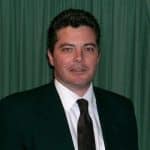
Jerry Spencer
Jerry has an Hons Degree in Soil Science (1988) from Newcastle Upon Tyne University. He then worked as a turf agronomist for the Sports Turf Research Institute (STRI) until 1993.
He gained a Grad Dip in Business Management from UTS in 1999. He has held a number of technical roles for companies such as Arthur Yates (Commercial Technical Manager) and Paton Fertilizers (Organic, turf specialty and controlled release fertiliser) portfolios.
In 2013 he established Gilba Solutions as independent sports turf consultants and turf agronomists. Jerry has written over 100 articles and two books on a wide range of topics such as Turf Pesticides and turfgrass Nutrition which have been published in Australia and overseas.



